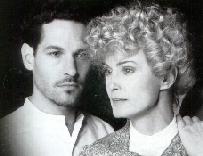SEARCH CurtainUp
REVIEWS
FEATURES
NEWS
Etcetera and
Short Term Listings
LISTINGS
Broadway
Off-Broadway
BOOKS and CDs
OTHER PLACES
Berkshires
London
LA/San Diego
DC
Philadelphia
Elsewhere
QUOTES
On TKTS
LETTERS TO EDITOR
FILM
LINKS
MISCELANEOUS
Free Updates
Masthead
Writing for CurtainUp NYC Weather
Long Day's Journey Into Night
By Lizzie Loveridge
Until at last everything comes between you and what you'd like to be -- Mary
 Jessica Lange, Paul Rudd (Photo: Alastair Muir) |
Eugene O'Neill's quasi-autobiographical play, written in 1941 but neither published nor produced until after his death, has come to London's West End. With Jessica Lange in the role of the mother, Mary Cavan Tyrone, the agony and wretchedness of O'Neill's family life is exposed in all its bleak rawness.
Ms. Lange gives a tender performance which becomes tempered by the course of the plot. Her increasing distance from the simpler loving mother figure mirrors the exposition of the troubles which plague the family -- her long-term addiction to morphine, acquired after the painful birth of her son Edmund (Paul Nicholls), the strained state of her marriage to the avaricious and inconsiderate James Tyrone (Charles Dance), the imminent confirmation of Edmund's consumption, and the elder boy, Jamie's (Paul Rudd) alcoholism and brothel frequenting. The first few scenes hint at the family's anguished past. The audience's growing knowledge of the rest parallels the onset of night and the break-down of harmonious family relations.
Lange in a large Edwardian wig, her hair drawn loosely into a bun on top of her head, bears an amazing resemblance in appearance, stature and voice to Kathryn Hepburn who portrayed Mary Sidney Lumet's 1962 film. In fact there were moments that Lange's performance seemed a replica of Hepburn's film role though in spite of this extremely moving. She starts out docilely enough. As she recounts the episode with the quack doctor that marked the start of her addiction, frenetically tugging at the tassels of a cushion, we get the sense of her pent up emotion. After the first interval she recalls her courtship with Tyrone to Cathleen, a servant, (Olivia Colman). The way she's stretched out on the chaise-longue, stroking herself like a contented cat in front of the fire, reminds us of the sensuality of lost youth and romance. We also see her anger as she blames her husband for his meanness in employing the inexpensive quack, for turning Jamie to drink. Later, in a metatheatrical moment Jamie says, "Enter Ophelia - mad scene", and Lange gives us all the desperation of the convent educated Catholic who lost her faith and became a hopeless heroin addict. This theme of undeserved blame placing continues as Mary blames Jamie for infecting his brother with the measles that killed him and blames her actor husband for asking her to tour with him instead of caring for the baby. Later, Edmund becomes part of this recrimination when the others hint that his difficult birth was the catalyst for the mother's addiction.
Charles Dance with his long wavy white hair and a white trimmed beard looks the part of the Irish rooted patriarch. In a stunning early scene, when Mary leaves the stage, we see the elder Tyrone and his sons take off their metaphorical gloves to bare fistedly attack each other. All the underlying tensions are exposed, as their interaction erupts into antagonism and rivalry. Nicholls is quite endearing as the poet son, Edmund, but maybe not quite sickly enough to convince that he has Tuberculosis. Paul Rudd seems almost too sympathetic to play the wastrel elder son, Jamie, although this expresses the pathos of his character, which has been shaped by his tragic background.
Robin Phillips direction is admirable, especially several beautifully arranged tableaux of the family group -- e.g. the times you see a son sitting talking to his father but with his back turned towards him, the body language showing the mutual mistrust. Simon Higlett's design of a pale house emphasises Tyrone's failure to spend anything on his own summer home while developing his property empire. The muslin walls allow us to see the fog circling outside, with the pale wood frames and lattice work giving us fascinating lighting patterns and shadows.
All in all this is a very worthwhile production. Jessica Lange earns a place in the gallery of memorable Mary Tyrones.
LINKS
Two American productions of the play reviewed at CurtainUp National Asian American Theatre Company (NATCO) . . .
Irish Rep Production
CurtainUp's O'Neill Page
| LONG DAY'S JOURNEY INTO NIGHT
Written by Eugene O'Neill Directed by Robin Phillips Starring: Jessica Lange, Charles Dance, Paul Rudd With: Paul Nicholls, Olivia Colman Design: Simon Higlett Lighting Design: Paul Pyant Sound Design: Matt McKenzie Running time: Three and a half hours with two intervals Box Office: 020 7494 5045 Booking to 3rd March 2001 Reviewed by Lizzie Loveridge based on 2nd December 2000 performance at the Lyric, Shaftesbury Avenue, London W1 |


